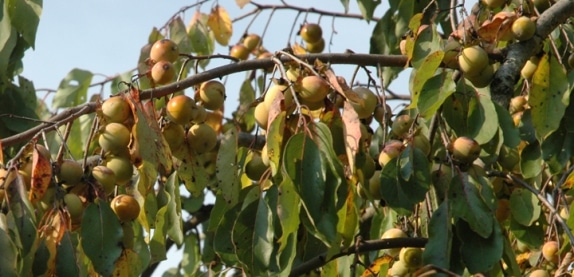If you think this is about people having sex in the woods, I’m sorry to disappoint. It’s about persimmon trees having sex in the woods. Far less interesting, I know, at least until hunting season arrives and it’s time to locate stands. Most of us know that deer are drawn to persimmon fruit as surely as your eye was drawn to the word “sex” in the title of this post. Fewer know there are male and female persimmon trees, and, as you might guess, only the female trees bear persimmon fruit.
It’s relatively easy to learn to pick out persimmons in the forest based on their simple, glossy leaves (sometimes splotched with black) and, in mature trees, the distinctive, charcoal-colored, checkered bark. However, if you hang your stand over a male persimmon tree, it’s going to be a quiet hunt.
Fruit, of course, is a dead give-away that you are looking at a female persimmon. Absence of fruit doesn’t necessarily mean a tree is a male. It could be a bad year for mast production, the tree might be in a location with poor resources (sunlight, soil nutrients and moisture), or it could just be an immature female that isn’t producing fruit yet. You can also safely “sex” a persimmon in spring, when the trees are bearing flowers, as each sex produces a distinct flower.
If you happen on a persimmon tree in the spring, check for flowers. You’ll find them on this spring’s new growth that is emerging from one-year-old limbs. The flowers form in the axils of the new growth – that’s the angle between a leafstalk and the branch the leaf is attached to (see the photo in the gallery below). Female flowers are slightly larger than males, and they are attached closer to the branch, because as the fruit forms and becomes heavy, a strong anchor to the branch will be necessary (again, more photos in the gallery). In contrast, male flowers dangle on a stem and almost appear like tiny bells (I promise I’m trying to keep this G-rated). Male flowers also have a “calyx” (the leaf-like cup that holds the flower) that is smaller than the flower. In females, the calyx is roughly equal in size to the flower. Finally, male flowers occasionally, but not always, form in clusters of two or more hanging from the same axil. Female flowers do not. If you see dangling persimmon flowers in a cluster of two or more, it’s a male tree.
So, get out there now and find female persimmons and flag them. If they’re large enough, or growing in groups, you have a great stand site for hunting season.
Fertility Enchancement
Let’s take this one step further, though, and get into active habitat management. Think about what I said about flowers – they form on new growth emerging from one-year-old wood. Therefore, a female tree in a crowded canopy or shady understory is naturally going to produce less fruit because it doesn’t have room or resources for a lot of new growth each spring. If you find a tree like this, crank the chainsaw and give the tree some room, more sunlight, and command of the moisture and soil nutrients within reach of its root system. This makes it possible for the tree to put on more new growth next spring, resulting in greater potential for fruit production. This applies to planting new persimmon trees as well. Always plant them, just as you should with any tree seedling, in full sunlight with plenty of space for crown growth. Full, healthy, expanding crowns will mean space on the tree for fruit production.
Sex Change
Interestingly, a male persimmon can be given a “gender reassignment” and made to bear fruit. Grafting is the ticket. During winter, “scion” wood is clipped off a known female and grafted onto a male seedling. Thereafter, any growth from the male base is suppressed and the female graft is allowed to become dominant. The result is a tree with male roots and a female crown that bears persimmon fruit. It’s actually not that difficult to do this. You’ll find instructions for persimmon grafting here.
Soft, Sweet and Tempting
If you find female persimmons this spring or summer and “release” them from competition, check back in the fall and taste the fruits of your labor. As a warning in case you don’t know, unripe persimmons are so bitter you will never again make the mistake of biting into one, but once they soften and turn ripe, they are uniquely delicious. Taste a ripe one and you will understand why whitetails, and a lot of other wildlife, go out of their way for persimmons.
